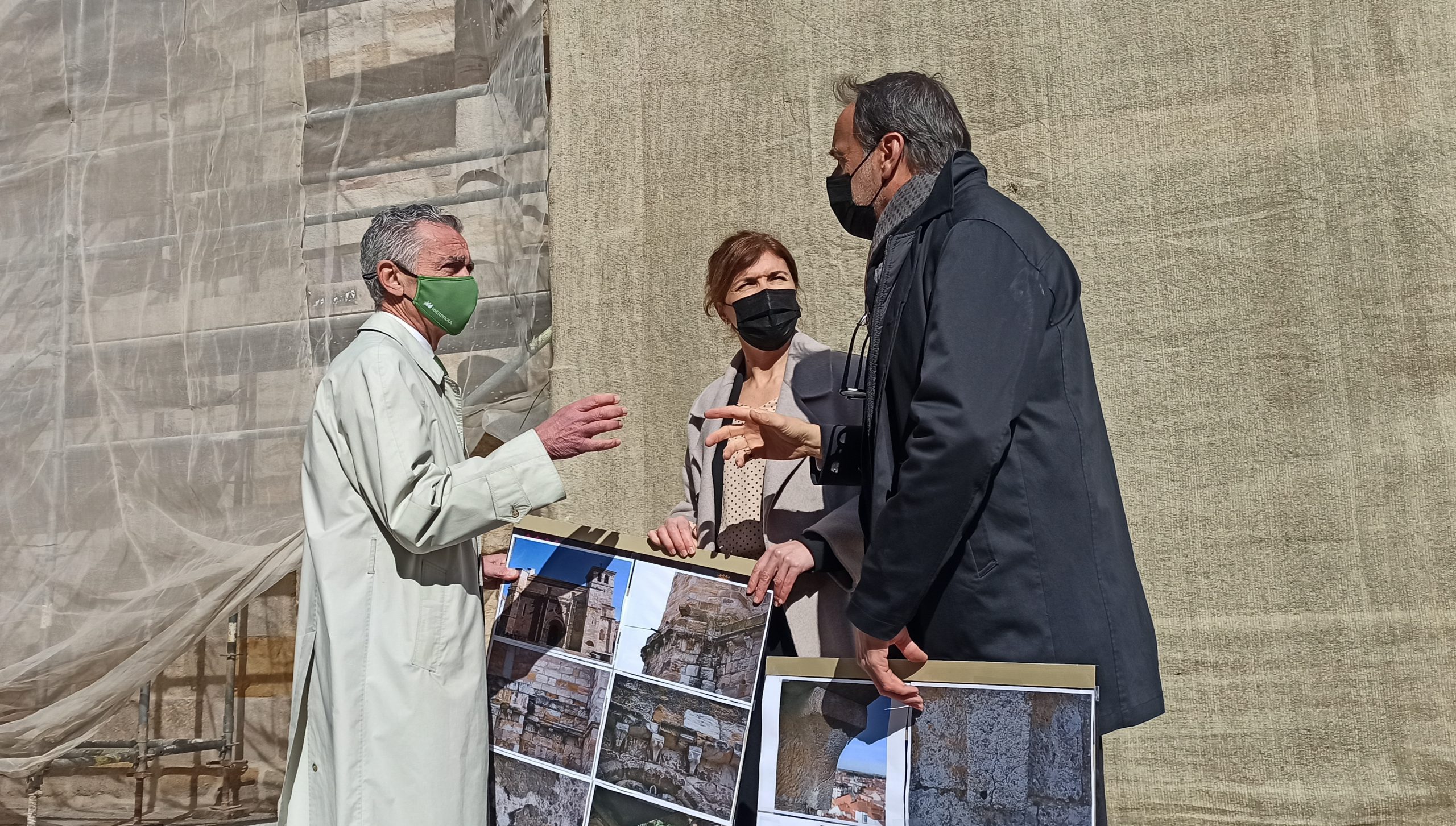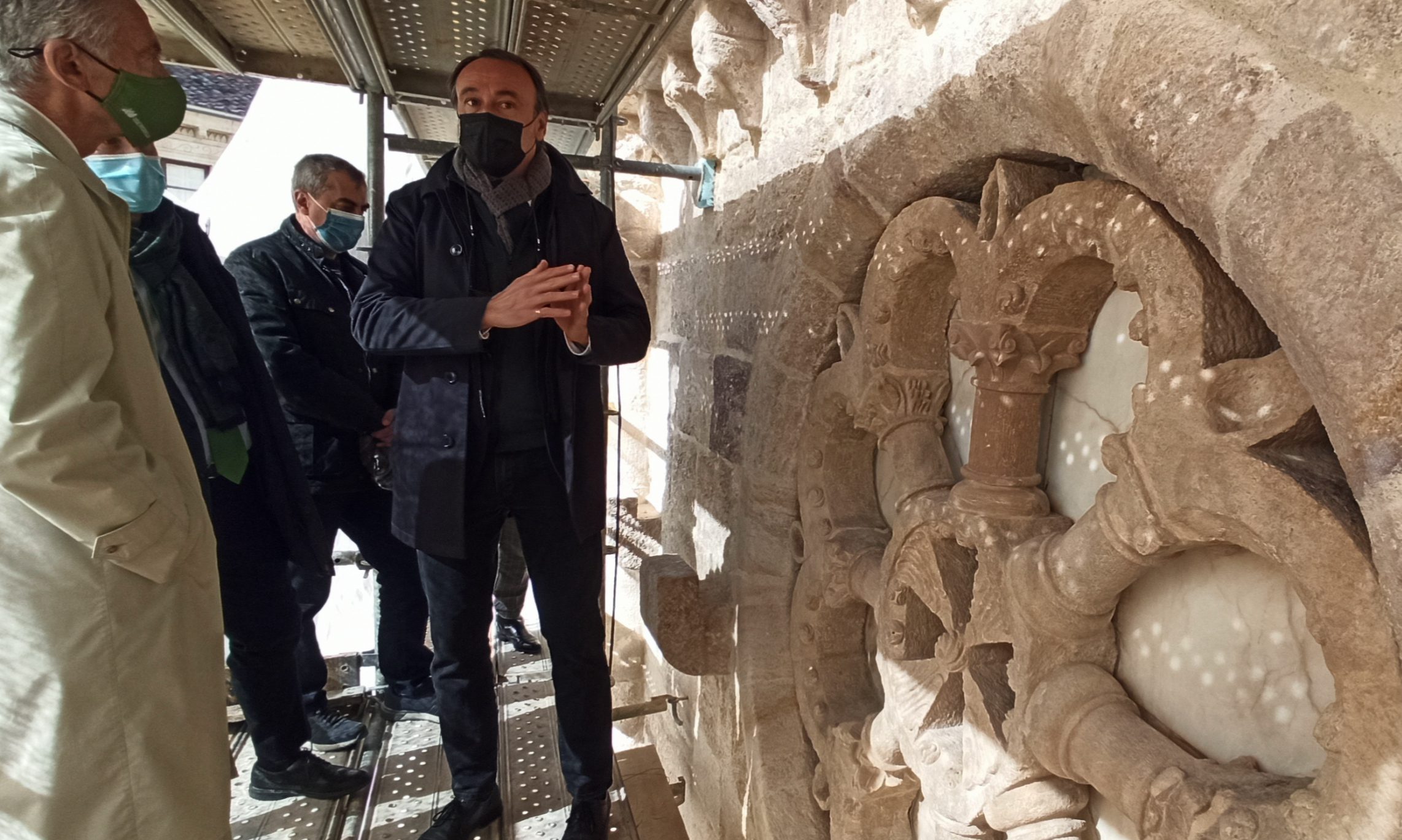- The territorial delegate of the Regional Government of Castilla y León in Zamora, Clara San Damián, the president of the Fundación Iberdrola España, Fernando García, and the diocesan delegate of heritage of Zamora, José Ángel Rivera, visited today the actions being developed in the Zamora churches of San Juan de Puerta Nueva and San Vicente, within the Atlantic Romanesque Plan, promoted by these entities.
- This example of institutional cooperation and public-private participation, in addition to focusing on the restoration and recovery of monuments, aims to enhance the value of an entire territory, promoting a sustainable, intelligent, and constant management of heritage.
The tour, in which they were accompanied by the project director, Jesús Castillo, from the Santa María la Real Foundation, and the Iberdrola delegate in Castilla y León, Miguel Calvo, began at the church of San Vicente. The work of the Atlantic Romanesque Plan focuses on the tower of the building, one of the most emblematic of Zamora’s Romanesque architecture, along with that of the cathedral.
The work, as explained, includes several aspects. The first step was to remove the stork’s nest and then proceed to the restoration of the roof, replacing and consolidating both the wooden boards and the slate slabs that were in poor condition. A waterproofing plate was also installed to protect the space. In addition, the walls have been cleaned and consolidated, removing dirt and vegetation, filling cracks and fissures with lime mortar, and reconfiguring the edges and volumes of the tower by employing stone grafts or restoration mortar.
In addition to these actions, the belfry has been protected from birds by placing a mesh in the openings of the tower to prevent birds from entering, without hindering ventilation. The intervention is completed with the cleaning and consolidation of both the historic flooring and the spindle, as well as the installation of new, more efficient lighting in keeping with the history of this Romanesque building.
San Juan de Puerta Nueva
A few meters away stands the church of San Juan Bautista, better known as San Juan de Puerta Nueva. Also of medieval origin, although with successive reforms over time. In this case, the intervention has focused on the south façade of the building, which has a tripartite articulation, with lateral apsidiole, a body of naves, and a turret at the foot.
The works consist of the cleaning and consolidation of the walls, replacement of lost stone elements, restoration of the roof and the historical floors, as well as the protection of the building’s openings.
In both interventions, different studies and preliminary tests have been carried out to corroborate the suitability of each of the treatments applied so that they are respectful with the building, with the environment, and follow the criteria of reversibility and minimum intervention.
Atlantic Romanesque Plan
The Atlantic Romanesque Plan is a cross-border cooperation initiative for the conservation of cultural heritage, which includes projects for the restoration and enhancement of twenty Romanesque temples located in the Spanish provinces of Zamora and Salamanca and the Portuguese regions of Porto, Vila-Real, and Bragança. This is an example of institutional cooperation and public-private participation since it is promoted by the Junta de Castilla y León, Fundación Iberdrola España, and the Portuguese Ministry of Culture.
It should also be recalled that in previous phases of the Atlantic Romanesque Plan, various actions had already been carried out in the province of Zamora, specifically in San Martín de Castañeda, in the Visigothic church of San Pedro de la Nave, in the church of Santa María Magdalena de Cozcurrita, in the church of San Juan de Fermoselle, in the murals of the church of San Juan de Fermoselle, in the church of San Martín de Castañeda, in the church of San Pedro de la Nave, and in the church of Santa María Magdalena de Cozcurrita, in the murals of the church of Santa Eulalia de Muga de Alba, in the church of Nuestra Señora del Carrasco de Pinilla de Fermoselle, in the church of Nuestra Señora de la Asunción de Pobladura de Aliste, in the church of Santa Marina de Sejas de Sanabria, or in the frescoes of the hermitage of Fernandiel, in Muga de Sayago.


